#pictish design
Text
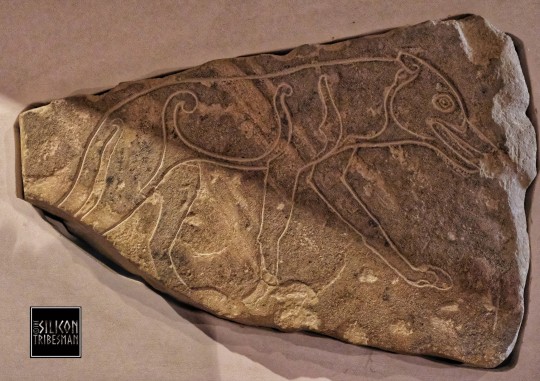


Inscribed Pictish Wolf Symbol Stone, Inverness Museum and Gallery, Inverness, Scotland
#Pictish#pict#pictish art#pictish beast#pictish design#pictish stones#pictish symbols#archaeology#Inverness#Scotland#wolf#beast#relic#artefact#ancient cultures#ancient craft#ancient living
421 notes
·
View notes
Text

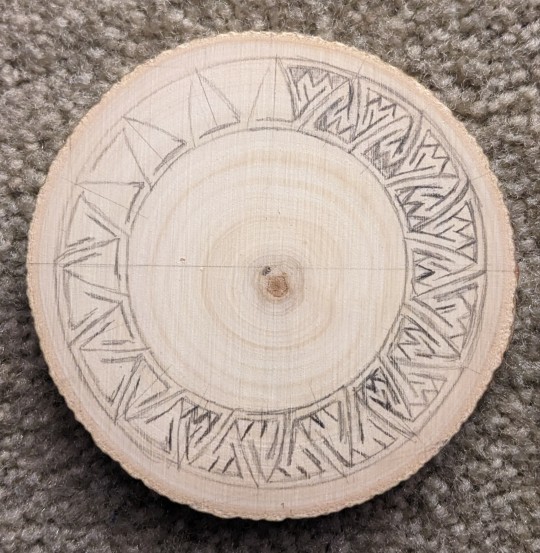
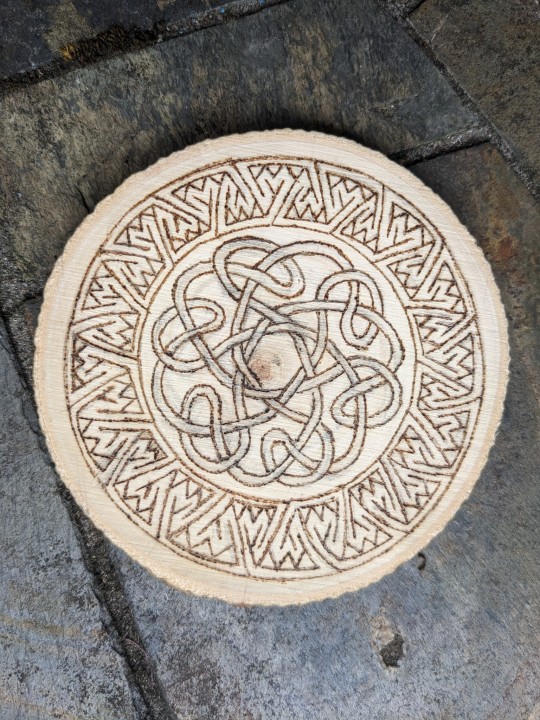

Geometry is a dark art.

🌻🌻🌻it looks so fucking legit wtf🌻🌻🌻
#art#my art#celtic knotwork#pictish design#woodburning#pyrography#sunflower#celtic sunflower#🌻#really over the moon with how this turned out#ludicrous
15 notes
·
View notes
Note
jeg så en anon delte drømmen sin med deg, så tenkte jeg får dele den drømmen jeg hadde jeg og her en natt; jeg hadde en drøm om skottland og norge forrige uke tror jeg?? hvor de lå i en gresseng og norge rullet rundt i gresset og lo mens skottland bare så på han og lo, og så plutselig kom det masse rosa hjerter ut av det blå😭💕💕💕 det var vikingtiden for norge gikk med gamledagse klær og hadde langt hår
😭😭 fyfaan så søtt 🥺💖 brukte alt for lang tid på denne. Hvem sier at drømmer ikke kan bli virkelige?

#hetalia#scotnor#historical hetalia#aph norway#aph scotland#hws norway#hws scotland#takk for at du deler drømmen din lol - skulle ønske jeg også hadde scotnor-drømmer 🥺#also I've changed Scotland's historical clothes so much by now - I really can't decide his outfit for this period#and I try to make him more Pictish but that's very hard to find references for - esp with colours#so I guess he'll keep changing 🤔#think I've finalized Norway's viking age design tho#more or less
51 notes
·
View notes
Photo
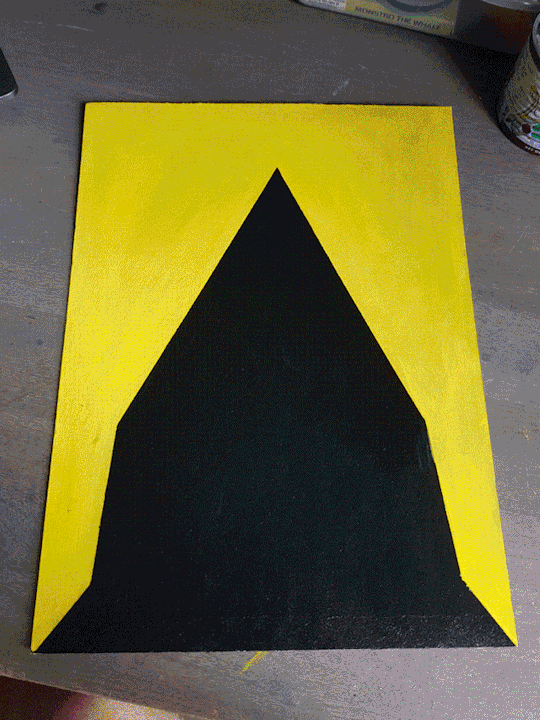
#illustration#folkart#process#tribal#triangle#design#fine art#fineart#painting#acrylic#mixedmedia#kozmiknougat#scotland#pictish#fantasy
5 notes
·
View notes
Text
The Picts. The Picts were an ancient group of people who inhabited the eastern and northern parts of Scotland during the late Iron Age. The etymology of their name, "Pict," is believed to come from the Latin word "Picti," meaning "painted or tattooed people," a reflection of their distinctive body art.
One of the most fascinating aspects of the Picts was their matrilineal heritage system. Unlike many other ancient societies that traced descent and lineage through the male line, the Picts emphasized matrilineal descent. This means that genealogical importance was given to the mother's line rather than the father's. Such matrilinear practices challenge our conventional understanding of hereditary systems in ancient times, emphasizing the unique cultural elements of the Picts.
The Picts are often famously associated with tattoos and body paint, particularly the color blue. Ancient writers, like the Roman historian Julius Caesar, wrote about the blue designs that adorned the bodies of these tribes, linking them with the use of woad, a plant from which a blue dye can be extracted. The Picts would create intricate designs, which were possibly symbols of their warrior status, clan affiliations, or religious beliefs.
During their conquest of Britain, the Romans faced resistance from tribes like the Picts. Their opposition wasn't just direct; they employed guerrilla tactics, leveraging the highland terrains. The Antonine Wall, akin to Hadrian's Wall, marked the Roman Empire's boundary and defended against the Picts. Though Romans tried to conquer the Picts, they never succeeded.
It should be noted, however, that much about the Picts remains shrouded in mystery. The Pictish stones provide some of the most direct evidence of Pictish culture and art, but their exact meanings and purposes are still debated among scholars. Despite the limited direct records from the Picts themselves, their influence on the shaping of Scotland's early history is undeniable.
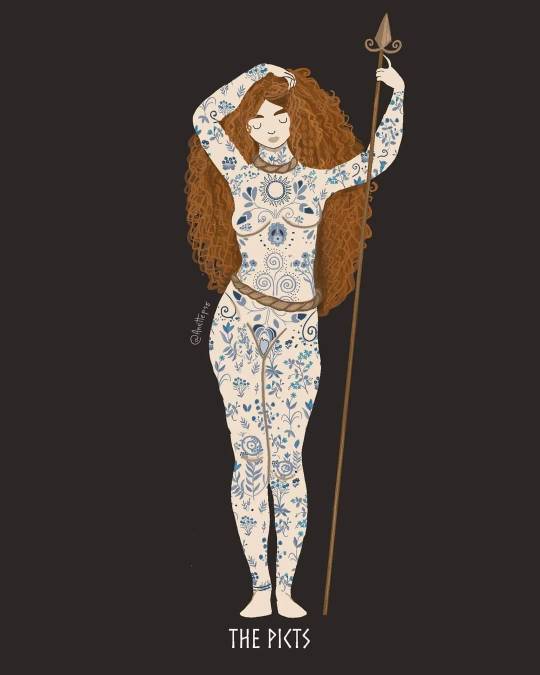
18 notes
·
View notes
Text
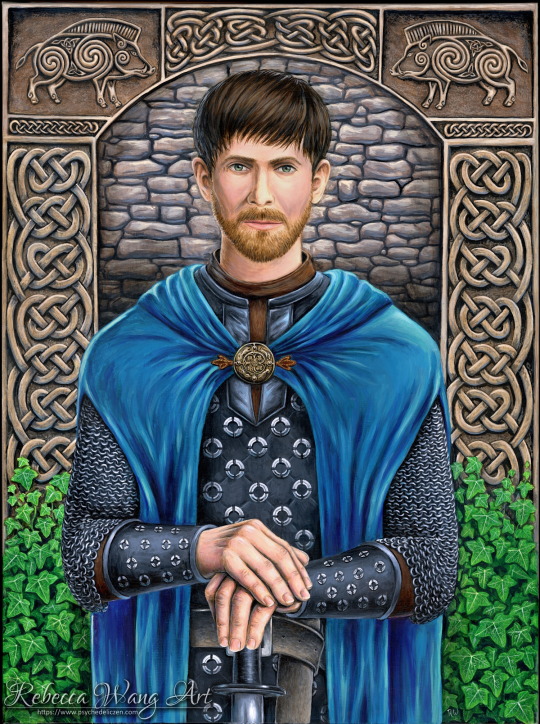
Lord Aldhelm of Mercia
The true king of Mercia. I will accept no other.
Acrylic painting on 18" x 24" stretched linen canvas, just finished last night. Took me about 180 hours over 6 months in between commissions.
I really hope this is a good likeness of him. This was the first time I have painted a person, aside from a few drawings I have done many, many years ago as commissions. My entire portfolio consists of pets, animals, and dragons; so this was astronomically outside of my comfort zone. I also never do fanart, so this is an absolute first for me. This painting was super challenging for me (so many different textures! omg.. chainmail....), and I learned a lot in the process. So please forgive any anatomical errors.
Just a few notes: the English Ivy in the background is more than just decorative; it represents devotion, fidelity and loyalty. The knotwork on the sides and across the top are adapted from the designs on the stonework of the pillars near the gates of Aegelesburg. The Pictish boars in the upper corners are my own design; the boar is the symbol of Mercia. The stone wall behind him was originally going to be a stained glass window, but I scrapped that because it was far too busy.
EDIT: I totally forgot to include some close up detail views of the painting!
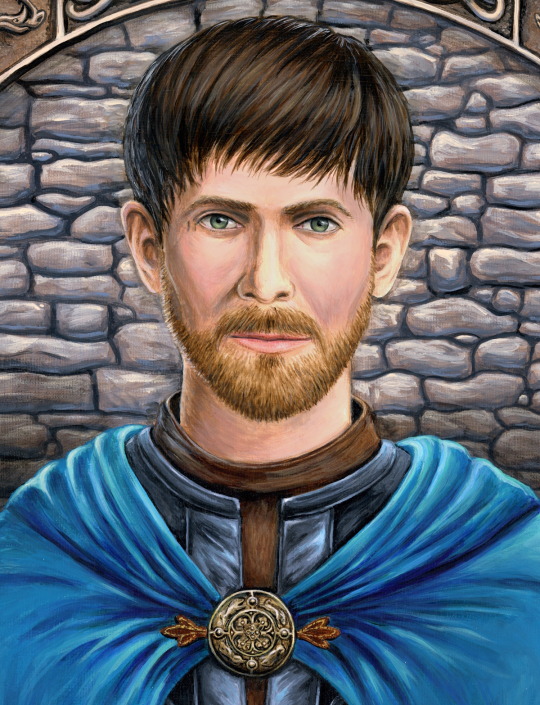


#art#artists on tumblr#rebecca wang#traditional art#acrylic painting#my art#aldhelm#the last kingdom#tlk aldhelm#lord aldhelm#tlk fanart#rebeccawangart
32 notes
·
View notes
Note
What would you recommend to an aspiring Celticist for a tattoo? My sister wants to get matching Celtic tattoos, and while I’ve started to study Celtic mythology, I’m definitely no expert lol. I know a lot of symbols you’d find on the internet are bullshit, and a lot of the real ones have a ton of baggage associated with them (literally the first thing I told my sis when she brought this up was that we had to be careful & do our research when picking these out bcs the nazis looove that shit). But what would you recommend? Is there anything we should definitely steer clear of? Thanks!!
I'm going to either be really helpful or really non-helpful: A lot of this will depend on you and your sister.
Like, for me, when I've thought of Celtic-inspired tattoos, they're always things that are very personal to me. Like, for example, Bres' name in Ogham on my wrist, since it's always been him and me surviving this together, the Children of Lir, because that's a personal good luck symbol (yes, the most notoriously UNLUCKY story in the Mythological Cycle -- I have a Children of Lir necklace that I wore when I was giving my Capstone Presentation in my undergrad, and I've worn it to every talk I've ever given, even to my interview with my current program), an image of an owl (for Blodeuedd) or something like the Pictish Beast, since I love marine animals and waterhorses in the folkloric tradition. So, I'd look at what appeals to you and your sister, your relationship, shared interests, etc.
There's only one Celtic image that's formally been designated as being a potential white supremacist symbol by the anti-defamation league, and that is the Celtic Cross.
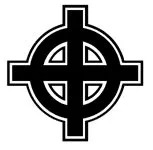
This is the image that most white supremacists will use, you'll notice that it has very short ends.
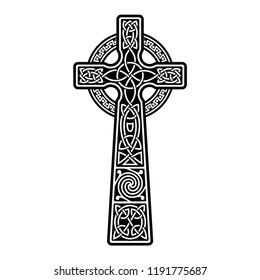
This is the more traditional Celtic cross -- you'll see these in just about every single tourist shop in Ireland, as well as in cemeteries. I'd be lying if I said that I don't still feel a bit of a jolt whenever I see the regular one in a tattoo; it shouldn't, because it's an image that is emblematic of Irishness and Irish heritage. And I don't feel that way about, say, a necklace, but a tattoo is much more different to me. It's permanent, it's...intimate. So I would suggest staying away from either version, even though the one at the bottom is NOT the one that has been appropriated by white supremacists.
I also tend to be distrustful of people who have like....mixed Celtic and Nordic symbols. Like, the Vikings did settle in Ireland, some Irish words are based in Norse terms, Cork, Dublin, and Waterford are Viking cities originally, there are a lot of folktales in common between Ireland and Norway, there are historic links there. That being said, anyone who treats them as being interchangeable (the term "Nordic-Celtic" makes me shudder whenever I see it in an organization's name and, no, I do not give a single fuck if you say that you aren't THAT kind of Nordic Celtic) raises my fight or flight response. Like, they're both part of this implicit idea of White Warrior Male Culture. But that's not a problem unless you're getting multiple tattoos. (Tbh, if I see a random Celtic knot on someone...I might think 'white supremacist' or I might think 'Irish American', it depends on everything else.)
...also a Celtic knot world tree symbol. Not because they're white supremacist, but because it isn't really based strongly in the Irish tradition.
Quite a few people in the field will get ogham tattoos, especially in Modern or Old Irish, possibly using a word or phrase that's important to them. One friend of mine has one that is a phrase that is related to their health problems and reflects their fortitude. You might get an image based on a particular story (I might actually choose the Children of Lir, just because, everything else about it aside...it does contain a really strong sibling relationship.)
Basically: Why do you want a Celtic-inspired tattoo (from any of the various Celtic cultures?) What are you interested in? What speaks to you as people?
12 notes
·
View notes
Text

Pictish goose - So happy with the response I have had to my recent work. I can’t wait to do more of my flash pieces in the new year!
I want to do more Pictish / Celtic designs as well, possibly exploring some ornamental concepts ☺️
#Pictish#trad tattoo#traditional tattoo#uk tattoo artist#tradtattoos#tattoo flash#uk tattoo#nature tattoo#tattoo artist#tattooartist#uktattoo#blackandgreytattoo#uk nature#ignorant tattoo#dotwork tattoo#ignorant style#bird tattoos
9 notes
·
View notes
Text
WIP - the start of a full Pictish sleeve. This section is based on a famous Pictish stone from Scotland. One of my favorite styles to design in and I can’t wait to continue this magnificent piece. Done at Ritual Tattoo in Berkeley.

7 notes
·
View notes
Photo

Queen of Wands. Art by Jemima Keziah, from The Leeds Tarot Card Project.
“The Queen of Wands is a future orientated card associated with fire signs, new growth, dedication, fertility and self-assured optimism. Recently I’ve been inspired by the histories and drawing techniques of ancient-early medieval Celtic and Pictish designs, so I drew up a nude woman with Pictish tattoos and knots in her hair, looking forward and firmly posed in mid air. I added dragons to her thighs, breathing the fire of a typical Leo placement, while she floats against a contrasting natural wood background pointing to growth and renewal. I had fun going a bit more out of my comfort zone to draw something digitally, and enjoyed working with new techniques and textured brushes to create a comic book effect. I found it super interesting to try and portray the metaphysical elements of tarot in such a two-dimensional and compact style too!”
15 notes
·
View notes
Note
where do you get inspo for cú chulainn’s blue markings? are they tattoos? i’ve tried to do research in celtic marking or tattoos, and i could only every find one source that talked about the britons. i’m curious because maybe one day i’d like tattoos/markings like that :)
Yep they’re just tattoos! Not really grounded in anything historical really, however I do take inspiration from pictish illustrations I’ve seen, going under a basic assumption folks across the sea would have been looking similar! More so I just add them purely for aesthetic purposes, or to loop in with a character (I always include a hound tattoo on Cú for example, so people recognise him at a glance) Inspirations for the designs are a combo of the geometric pre Christian carvings found in sites like Newgrange, etc, as well as general Celtic-ish designs, and bits from the Book of Kells. So a wide range really!
6 notes
·
View notes
Text


Pictish Inscribed Symbol Stone, Inverness Museum and Gallery, Inverness, Scotland
Crescent and V-Rod, Conjoined Ovals, Wester Balblair, Beauly. Inverness
#pictish stones#pict#pictish design#pictish beast#archaeology#pictish art#ancient craft#ancient cultures#ancient living#relic#artefact#Inverness#Scotland#Ancient Scotland
54 notes
·
View notes
Text


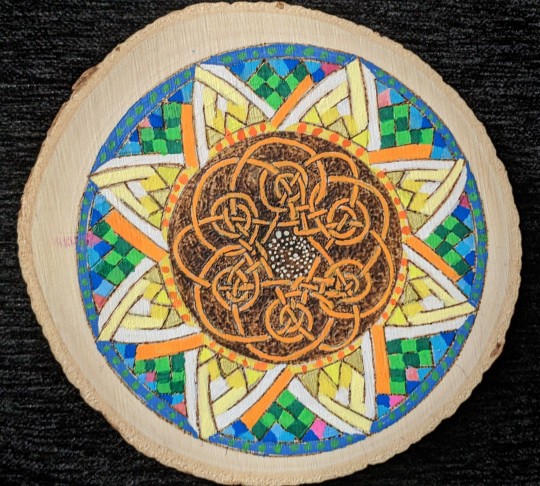
daisy 🌼
The knot was so incredibly difficult and I had to copy it so many times because I couldn't do it small so I did it big to figure out how it worked and then small for the pattern but that small wasn't small enough so I had to redraw it even smaller, ink it, copy it onto tracing paper, copy that onto the wood, burn it into the wood, and then finally color it in. But each time is a ~learning experience~.
Spiral knotwork is based on the Fibonacci sequence, and is a single interwoven line.
#art#celtic art#celtic knotwork#pictish design#woodburning#pyrography#thanks to my fab mil for the paint pens
16 notes
·
View notes
Note
Very important question, what are some symbols that are affiliated with la’ara, do they have a specific insignia that isn’t the inquisition? (Professional reasons of course)
Professional of course.
I do an embarrassing amount of thinking about La'ara's symbology lmao. Big motifs for them are of course the various Dalish insignias, and I talked about their tarot cards here. La'ara's original clan, O'Cathasaigh, is based on the idea that various Dalish clans developed different cultural practices, with clan O'Cathasaigh being based on pre-Roman conquest Ireland and the early Celtic and Pictish influences there.
The triquetra is also another specific symbol I picture them wearing a lot, kind of married with Dalish tree motifs, like this:

Their vallaslin, which is Ghilan'nain's, is also based on motifs connected to Cernunnos, as they have really quite similar symbols.

Additionally, the blue color is based on stories of Pictish warriors wearing blue paint--whether it was made of woad is unclear historically, but I like to think Clan O'Cathasaigh's special blue vallaslin is made from dye derived from royal elfroot, which grows most commonly just inland of the Storm Coast.

In addition to Dalish tree motifs, I give them a lot of Celtic-style halla designs, mostly inspired by this pendant:

And in general, Celtic knotwork and linework, greenery, and water are just basic inspirational elements. This is tangentially connected to symbology, but I also associate them with Isolde/Iseult (for romance reasons), Ophelia (for well of sorrows reasons), and Boudica (for very Dalish reasons and rejection of the title Herald).
I know this was a long post lol but I hope it was interesting! Thank you bb for the question ❤️
13 notes
·
View notes
Photo
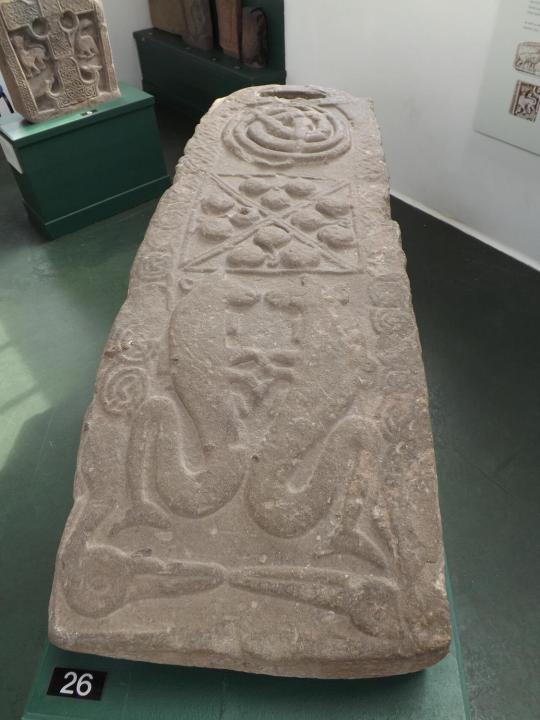





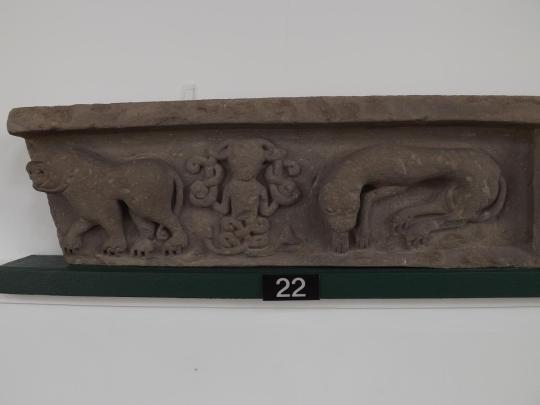
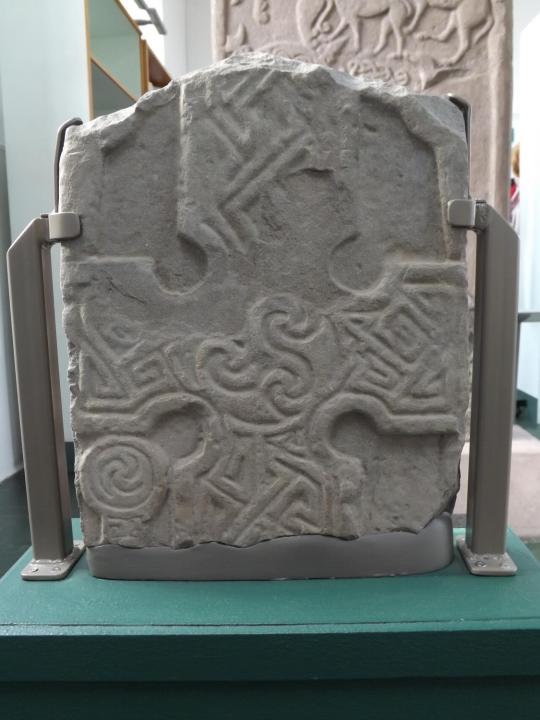


Some more from the Meigle Museum. Uppermost is the top of the recumbent stone from the last set, showing a pair of mer-cows, a couple of storks or possibly herons, and a sort of triskele design made up of three snakes all biting each other’s necks. Then we have:
Two faces and the side of Meigle 5, showing a cross surrounded by animals, a bloke on a horse (’bloke on a horse’ is also a common motif in Pictish art), and a deeply-incised mirror and Beast.
Meigle 6, with another bloke on a horse, a double-disc, a crescent (no rods involved for once, either Z or V) and a horse, and the shaft of a cross on the other side; this stone would’ve been a bit taller once but has clearly been broken off at some point.
Meigle 22, a piece of a high-relief frieze showing a strange figure that’s been variously interpreted as some kind of water-spirit, a siren, and a local version of the god Cernunnos, flanked by two wild animals. The one on the right looks like an otter to me, which would tie in with the water-spirit idea.
The two sides of Meigle 3, with a cross and another bloke on a horse.
Meigle 7 and 27, showing respectively a double-disc-and-Z-rod and a person crouching behind a chair. Possibly this is meant to represent the servant of the larger incomplete figure sitting in the chair. Or you never know, maybe no centre of Pictish culture was complete without a dedicated throne-gremlin.
5 notes
·
View notes
Text
The Maiden Stone and Persephone
The Maiden Stone and Persephone
The Maiden Stone
The beautiful pink granite Maiden Stone stands near Inverurie in Aberdeenshire. It is an 8th century Pictish stone. On one side it bears designs favoured by the Picts, such as the comb and mirror, the mysterious Pictish Beast (Dolphin? Elephant? Mermaid? Nobody knows…) and a centaur at the top.
On the other side there is a very worn Celtic Cross, indicating that this may have…

View On WordPress
#Aberdeenshire#folklore#history#mythology#pictish stones#picts#Scotland#scottish history#standing stones#statue
3 notes
·
View notes